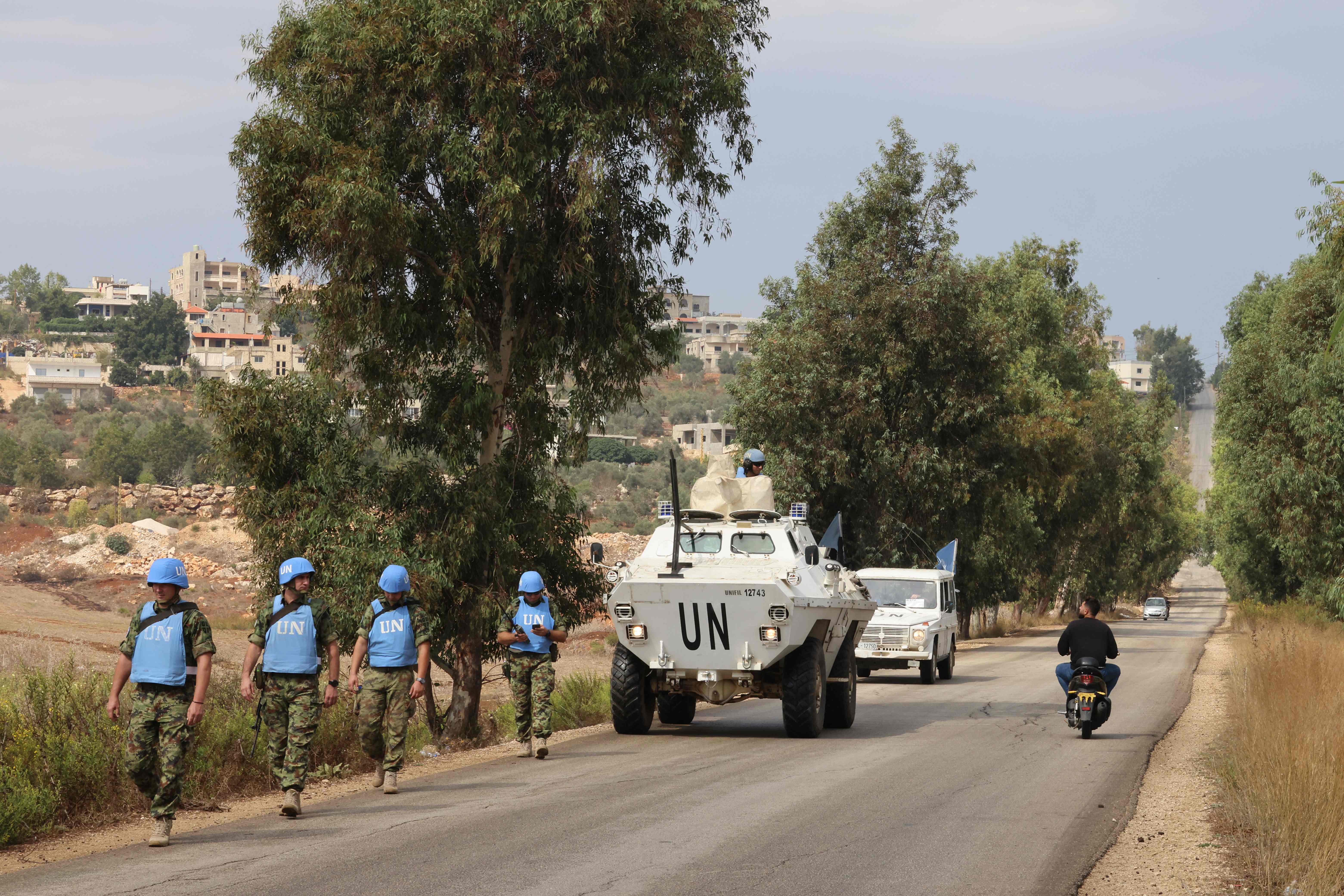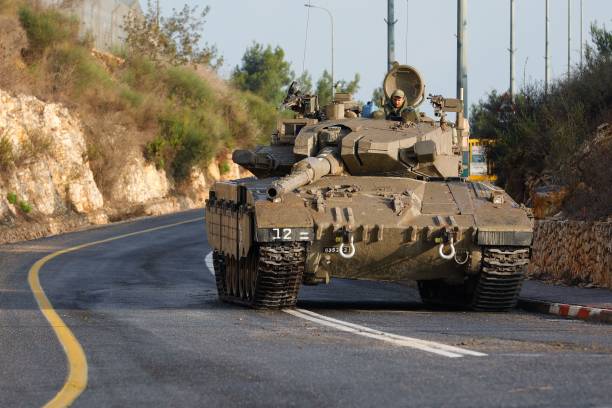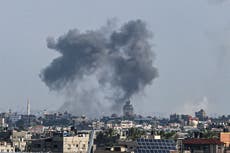Will Hezbollah, Israel’s Lebanese militant enemy, enter the Gaza conflict?
A set of delicate and unwritten rules of engagement has ensured no major conflict between Israel and Hezbollah since 2006. But those rules are now being tested, Richard Hall writes.

Your support helps us to tell the story
From reproductive rights to climate change to Big Tech, The Independent is on the ground when the story is developing. Whether it's investigating the financials of Elon Musk's pro-Trump PAC or producing our latest documentary, 'The A Word', which shines a light on the American women fighting for reproductive rights, we know how important it is to parse out the facts from the messaging.
At such a critical moment in US history, we need reporters on the ground. Your donation allows us to keep sending journalists to speak to both sides of the story.
The Independent is trusted by Americans across the entire political spectrum. And unlike many other quality news outlets, we choose not to lock Americans out of our reporting and analysis with paywalls. We believe quality journalism should be available to everyone, paid for by those who can afford it.
Your support makes all the difference.As the Israeli army mounted its response to the massacre of hundreds of civilians by Hamas this weekend, it sent tanks and troops not only to the scene of the atrocities, but to its northern border with Lebanon.
It was a recognition, borne from experience, that an all-out offensive against Gaza is unlikely to be contained there. To Israel’s north lies a much more formidable foe, and ally of Hamas, the Lebanese Shia militant group Hezbollah.
Recent skirmishes on the border have heightened the possibility that Hezbollah could enter the fray and widen the conflict beyond Israel’s borders. The group is significantly better equipped than Hamas, with an arsenal of tens of thousands of sophisticated rockets, according to Michael Knights, a fellow at the Washington Institute and expert on Iran-backed militias.
“Israel says the Hamas attack involved about 1,500 commandos entering Israel: Israel has assessed that Hezbollah has a 45,000-strong regular army,” he told The Independent. “Hamas fired about 3,300 missiles and drones so far: Hezbollah has around 150,000 munitions ready to fire.”
The entry of Hezbollah into the conflict would mark a dramatic escalation in an already devastating war between Israel and Hamas, which has seen the death of more than 1,000 Israelis and 800 Palestinians as of Tuesday.
Such an eventuality would ensure a regional war that would almost certainly cause massive civilian casualties in Lebanon and Israel, and potentially draw in other Iranian-backed groups throughout the region.
At stake is the balance of power in a regional proxy war between rivals Israel and Iran. The Islamic Republic has spent years building a network of allied militant groups opposed to Israel, which it collectively calls “the resistance.” Those groups — Hezbollah in Lebanon, Hamas in Gaza, Houthi rebels in Yemen and various Shia militant groups in Iraq and Syria — have been furnished with military training, financial support, missiles, and the ability to make their own missiles.
The consequences of that alliance were demonstrated in 2006, when Hezbollah and Israel fought a 34-day war that led to the deaths of 1,200 people in Lebanon, mostly civilians, and 157 Israelis, mostly soldiers. In that confrontation, which was sparked when Hezbollah fighters attacked an Israeli army convoy patrolling the border, killing three soldiers and taking two hostages, Israel pummelled civilian infrastructure across Lebanon, including in the capital, Beirut. Hezbollah fired more than 4,000 rockets into Israel, killing dozens of civilians.
The 2006 war ended with a United Nations-brokered ceasefire in August of that year. In the aftermath, despite suffering significantly more casualties, Hezbollah claimed a strategic victory because it maintained its ability to continue firing rockets.
Since then, Israel claims Hezbollah has drastically increased its stockpile of missiles, most of them unguided, which could wreak havoc across Israel. The group also gained valuable battlefield experience by sending thousands of its fighters to join Syrian government forces in that country’s civil war.

Anticipating that Hezbollah may be preparing for such a move, the US, Israel’s most staunch ally, sent an aircraft carrier strike force to the Eastern Mediterranean in what a defence official described as “a deterrent signal to Iran, Lebanese Hezbollah, and any other proxy across the region” who were weighing joining the conflict, the Wall Street Journal reported.
Speaking on Tuesday afternoon, US president Joe Biden appeared to reinforce that signal. Although he did not mention Hezbollah by name, he issued a warning “to any country, any organisation, anyone thinking of taking advantage of this situation.”
The question that now lingers over the residents of Lebanon and Israel is what precisely would initiate Hezbollah’s entry into the conflict? The answer depends on a complex cat-and-mouse game played out with missiles and artillery in the restless border region.
Despite intermittent skirmishes, both sides have gone to great lengths to avoid another widespread outbreak of hostilities in the intervening years. Firas Maksad, Senior Fellow at the Middle East Institute in Washington DC, told The Independent that an “unwritten understanding” has developed between the two sides, which determines which actions are permissible without sparking an escalation.
“In terms of the delicate rules of engagement between Israel and Hezbollah, I think it’s important to remember that the two parties have had a 40-year history of confronting each other across both sides of that border, which has also lent itself to a better understanding of each other’s intentions and objectives,” he said.
“The big question here, in the coming days, is whether there is going to be room for misunderstanding and miscalculation. Tensions are definitely very high,” Maksad added.
“And will Hezbollah flat out come to the rescue of Hamas, should Benjamin Netanyahu make good on his threat to commence a total ground invasion of Gaza?” Maksad asked. “My educated guess is that it’ll be very difficult for Hezbollah and Iran, their regional sponsor, to sit idly by and watch the Palestinian leg of the Iranian axis be dismantled.”
These established rules of engagement between Hezbollah and Israel have been tested in recent days. On Sunday, Hezbollah fired at three Israeli positions in the disputed Shebaa Farms area. Monday was the deadliest day on the Israel-Lebanese border since the 2006 war. Fighters from the Palestinian Islamic Jihad group, which has a presence in Lebanon, attempted to infiltrate Israel, resulting in the death of two of its members and the killing of an Israeli officer. Hezbollah fired at two more Israel military posts near the border, and the UN peacekeeping force in Lebanon’s south also said a number of rockets were launched near the Lebanese city of Tyre. Hezbollah said three of its fighters were killed in Israeli shelling that came in response.

Hezbollah maintains tight control of the border region with Israel, making it almost impossible that the actions taken by Palestinian groups in Lebanon were carried out without its approval.
As Israel stepped up its bombardment of Gaza on Tuesday, another barrage of rockets were fired from Lebanon into Israel, and Hezbollah fired a guided missile at an Israeli military vehicle.
Hezbollah’s aim, according to Maksad, is to dissuade Israel from carrying out a full ground invasion of Gaza.
“I think we can expect more of that in the coming days,” he said. “I think [Hezbollah] will use third parties like Palestinian militant groups on Lebanese land to have them claim these operations, but with the understanding that they’re operating with Hezbollah’s approval.”
“They will find creative ways to try and harass and deter Israel from an all out operation,” Maksad said.
But this delicate game of deterrence carries with it risks of an explosion. Should Israel invade Gaza, as it has promised, and Hezbollah enters the war from the north, the US may also be dragged in.
“The messaging is that Israel, together with the United States, might retaliate not only against Hezbollah, but also against their ally, the Syrian regime in Damascus. The message is we are going to exact revenge from Iran’s Palestinian arm, and should Iran and Hezbollah try to come to the rescue, we will also then destroy your Syrian arm,” Maksad said.
“We’re seeing a game of attempted mutual deterrence. It’s dangerous because while both sides are arguably trying to deter each other and don’t want to see a full-scale regional conflict, that kind of posturing might lead to that regional conflict that all sides don’t want to see.”
As Israeli forces continued to count the dead from the brutal killings by Hamas on Tuesday, it intensified its bombing of Gaza, reducing a large part of Gaza City’s Rimal neighborhood to rubble overnight. Israel has imposed a strict blockade of the territory by air, land and sea for 16 years, a measure that the UN has described as “collective punishment” of its 2.3 million inhabitants, and which has caused a “completely collapsed economy, devastated infrastructure and a barely functioning social service system.”
Knights, meanwhile, believes the massacre of hundreds of civilians by Hamas may alter the previously set rules of engagement.
“Both sides are fairly careful and have well-understood parameters that have been exercised and tested hundreds of times in real life,” he said. “But one aspect has changed: Israel’s risk acceptance and emotional state. This could lead to over-reaction and escalation.”



Join our commenting forum
Join thought-provoking conversations, follow other Independent readers and see their replies
Comments